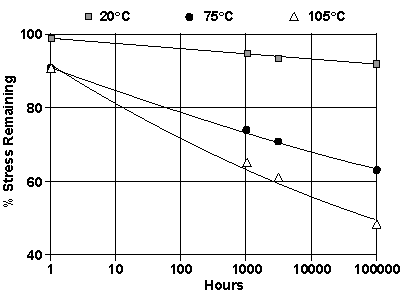This is a critical factor. Elevated temperature exposures result in the risk of loss of circuit integrity due to stress relaxation. The most popular connector metal, cartridge brass , does not fare well with exposure to elevated temperatures. The figure below shows that cartridge brass can easily lose half its contact force at 105°C; even at 75°C it can lose a third.
The stress relaxation behavior of a given alloy and temper can be predicted with reasonable reliability if this specific set of conditions has been tested at a range of temperatures for reasonably long times. The estimate can be made by constructing the probable curve for an intermediate temperature and extrapolating the straight line portion to longer times, if necessary.
When choosing the temperature of the connector environment the designer should keep in mind that the tests of specific materials are run in a controlled environment and a nearly constant temperature. A particular connector may be expected to encounter a range of temperatures depending on the ambient temperature and its own operating conditions. The effects of this thermal cycling are essentially unknown. Long experience suggests that this factor is not of major importance, although any effects may have been masked by the use of safety factors by the designer.
 Figure 1. Stress Relaxation of Cartridge Brass at Several Test Temperatures
Figure 1. Stress Relaxation of Cartridge Brass at Several Test Temperatures